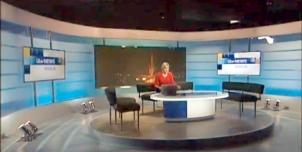Full Freeview on the Tacolneston (Norfolk, England) transmitter
| Google Streetview | Google map | Bing map | Google Earth | 52.518,1.139 or 52°31'6"N 1°8'22"E | NR16 1DW |
The symbol shows the location of the Tacolneston (Norfolk, England) transmitter which serves 330,000 homes. The bright green areas shown where the signal from this transmitter is strong, dark green areas are poorer signals. Those parts shown in yellow may have interference on the same frequency from other masts.
This transmitter has no current reported problems
The BBC and Digital UK report there are no faults or engineering work on the Tacolneston (Norfolk, England) transmitter._______
Digital television services are broadcast on a multiplexes (or Mux) where many stations occupy a single broadcast frequency, as shown below.
64QAM 8K 3/4 27.1Mb/s DVB-T MPEG2
DTG-12 QSPK 8K 3/4 8.0Mb/s DVB-T MPEG2
H/V: aerial position (horizontal or vertical)
Which Freeview channels does the Tacolneston transmitter broadcast?
If you have any kind of Freeview fault, follow this Freeview reset procedure first.Digital television services are broadcast on a multiplexes (or Mux) where many stations occupy a single broadcast frequency, as shown below.
64QAM 8K 3/4 27.1Mb/s DVB-T MPEG2
DTG-12 QSPK 8K 3/4 8.0Mb/s DVB-T MPEG2
H/V: aerial position (horizontal or vertical)
Which BBC and ITV regional news can I watch from the Tacolneston transmitter?

BBC Look East (East) 0.8m homes 3.2%
from Norwich NR2 1BH, 16km northeast (37°)
to BBC East region - 27 masts.
70% of BBC East (East) and BBC East (West) is shared output

ITV Anglia News 0.8m homes 3.2%
from NORWICH NR1 3JG, 16km northeast (38°)
to ITV Anglia (East) region - 26 masts.
All of lunch, weekend and 80% evening news is shared with Anglia (West)
Are there any self-help relays?
| Gt Yarmouth | Transposer | 1 km S town centre | 30 homes |
| Lowestoft (2) | Transposer | Rotterdam Rd | 125 homes |
How will the Tacolneston (Norfolk, England) transmission frequencies change over time?
| 1950s-80s | 1984-97 | 1997-98 | 1998-2011 | 2011-13 | 2013-18 | 2013-17 | 17 Jul 2018 | ||
| VHF | C/D E | C/D E | C/D E | E | E T | W T | W T | ||
| C3 | BBCtvwaves | ||||||||
| C31 | com7 | com7 | |||||||
| C32 | _local | ||||||||
| C37 | com8 | com8 | |||||||
| C39 | +ArqB | +ArqB | ArqB | ||||||
| C40 | BBCA | ||||||||
| C42 | SDN | SDN | SDN | SDN | |||||
| C43 | D3+4 | ||||||||
| C45 | ArqA | ArqA | ArqA | ArqA | |||||
| C46 | BBCB | ||||||||
| C50tv_off | BBCB | BBCB | |||||||
| C52tv_off | C5waves | C5waves | |||||||
| C55tv_off | BBC2waves | BBC2waves | BBC2waves | -BBCA | -BBCA | -BBCA | com7tv_off | ||
| C56tv_off | COM8tv_off | ||||||||
| C57tv_off | LNR | LNR | |||||||
| C59tv_off | ITVwaves | ITVwaves | ITVwaves | -D3+4 | -D3+4 | -D3+4 | |||
| C62 | BBC1waves | BBC1waves | BBC1waves | BBCB | |||||
| C65 | C4waves | C4waves | C4waves |
tv_off Being removed from Freeview (for 5G use) after November 2020 / June 2022 - more
Table shows multiplexes names see this article;
green background for transmission frequencies
Notes: + and - denote 166kHz offset; aerial group are shown as A B C/D E K W T
waves denotes analogue; digital switchover was 9 Nov 11 and 23 Nov 11.
How do the old analogue and currrent digital signal levels compare?
| Analogue 1-4 | 250kW | |
| SDN, ARQA, ARQB, BBCA, D3+4, BBCB | (-4dB) 100kW | |
| com7 | (-9.6dB) 27.4kW | |
| com8 | (-10.2dB) 24kW | |
| Mux 1*, Mux 2*, LNR | (-14dB) 10kW | |
| Mux A*, Mux B*, Mux C*, Mux D* | (-17dB) 5kW | |
| Analogue 5 | (-18dB) 4kW |
Local transmitter maps
Tacolneston Freeview Tacolneston DAB Tacolneston TV region BBC East Anglia (East micro region)Which companies have run the Channel 3 services in the Tacolneston transmitter area
|
|
Friday, 8 March 2019
H
hardy10:53 AM
Bury St. Edmunds
Harry . there are some problem areas near Bury .The coverage report was based on IP32 6NT Its just possible you are in one of these . Also check that your TV is tuned to Tacolneston . The local relay transmitter only has limited channels .
| link to this comment |
hardy's: mapH's Freeview map terrainH's terrain plot wavesH's frequency data H's Freeview Detailed Coverage
Saturday, 9 March 2019
H
Harry7:12 AM
MikeP: Thank you for replying Mike.
Yes, I do get 101 to 106.
My aerial is wideband (SLx 27884K4 4G Filtered 48 Element Aerial).
I'm aware Tacolneston is C/D.
In the manual tuning page I see the following channels
40, 41, 45, 29, 39, 46 and 44.
I am suprised to see some channels that I did not expect to see which might mean I'm not tuned on to Tacolneston. But that is strange because I'm pointing towards it and there aren't any other transmitters in that general direction. Secondly, all channels for Tacolneston say Hmax except for C55 and C56 which are H -5.6dB and H -6.2dB. I'v tried to slightly tilt my aerial to no avail.
| link to this comment |
H
Harry7:17 AM
hardy: Thank you for replying hardy. I'm pretty sure the postcode is alright and I've checked the trouble areas around Bury on the map, it seems we ought to be clear. I will double check the connections.
The aerial is fitted in the loft and the house is fairly tall with no obvious taller obstructions outside.
How would I check if I'm tuned to Tacolneston? I'm getting a few channels that are not listed on the Tacolneston channel list. The aerial is pointing in that direction and there doesn't seem to be any other transmitters from that direction. Could the coax cable act like an aerial?!...
I get 2 lights on the DVB-T Signal Strength Finder.
| link to this comment |
MikeP
10:38 AM
10:38 AM
Harry:
Then you need to manually tune in to the multiplexes broadcast from Tacolnston, all 8 of them. You are clearly tuned to another transmitter as well, probably because a TV aerial can receive signals from behind as well as in front. Use the channel number data provided by the Digital UK Coverage Checker for your post code, choosing the Detailed view, and look at the listing for Tacolnston.
Tacolnston is NOT group C/D, it was but is no longer hence the need for a wideband aerial.
| link to this comment |
J
Jos10:57 PM
Norwich
Hi,
Our postcode is NR12 0HS. According to the Digital TV coverage checker, most of our channels seem to be in group B, with just COM7 HD and COM8 HD in group T. I am thinking that we need a wideband aerial to received all channels, but wondered if we would suffer from less interference (from Dutch transmitters?) and a stronger signal if we give up on the COM channels and use a B aerial?
Thanks for any thoughts on this issue!
| link to this comment |
Jos's: mapJ's Freeview map terrainJ's terrain plot wavesJ's frequency data J's Freeview Detailed Coverage
Monday, 11 March 2019
J
Jos10:05 AM
Hi,
Just to add a little information, we run a small caravan park (9 letting caravans + 3 TVs in our house) and during last summer had some issues with pixellation and complete loss of signal on some channels throughout the site. It's entirely possible that the problem was due to the weather, exacerbated by a slightly damaged wideband aerial, and/or the old cable from the aerial to the amplifier, both of which we plan to replace now. But having read around the subject to prepare for changing the aerial, I'm wondering if we would have a more reliable signal with the main channels is we used a B group aerial instead of a wideband aerial. The TVs are all Freeview.
Also, how do we know if we would benefit from a high gain aerial? The checker says that our reception is variable, and is predicted to be worse from June 2019, so we are trying to plan ahead and improve the system as much as possible.
Thanks,
Jos
| link to this comment |
MikeP
10:57 AM
10:57 AM
Jos:
The use of a Group B aerial will not help. Firstly, you are likely to lose some channels. Secondly, it will not change the risk of signals from across the water . The high pressure systems are well known to cause signals to travelmuch further than is usual and theype of aerial will not affect that at all as it is a natural phenomenon.
The use of a high gain aerial also means that the aerial is more directional, the more elements on the aerial the narrower the reception angle so it is less likely to pick up unwanted signals - but it will still be affected by signals from the same direction as the wanted signals.
So I would advise not having a Group B aerial but it may be worth trying a more directional, hence higher gain, aerial. Good quality cables are essential as are good connections throughout the system.
| link to this comment |
H
Hardy9:29 PM
Harry . A group B probably would work well because it has a max response near uhf channels 55 and 56. However probably better to have a wideband .possibly a log type , as the future plan is that only channels below 50 will be used. A loft aerial may be ok in such a strong signal area but position may be important . Since there are reflections indoors you loose some directivity . A group B would be more upset by indoor use than a log too.
| link to this comment |
H
hardy11:04 PM
ignore my last post . mixed up who I was replying to.
Jos . I think an 18 element standard group B would only give a temporary improvement as it has a peak around UHF 55 . however in future there will be a change at the transmitters so that only channels below 50 will be used .Therefore a wideband high gain is probably the best you can do in such a difficult area . It might be possible to get a restricted but reliable range of channels from West Runton relay but the aerial would need to be vertically polarised.
with such a poor signal I would switch to Freesat .
| link to this comment |
Thursday, 14 March 2019
H
hardy11:30 AM
Jos I am very near to you at Mundesley . I use a log aerial with an on mast amplifier for Tacolneston and accept that occasionally in high pressure weather I WILL get some continental interference . Perhaps the best you can do is use a "grid" aerial with an amplifier as these have vey low pick up in the reverse direction . But cost around twice as much as a standard aerial.
| link to this comment |
Select more comments
Your comment please!





